From California to Alaska, wildlife photographer Bob Whitney drives his Hallmark Cuchara deep into the wilderness in search of fowl play.

Every year, we are completely blown away with the quality of the photography entered in our annual Truck Camper Magazine Calendar Contest. The reason why truck camper owners are such amazing photographers is simple. First, our off-road capable and highly maneuverable rigs allow us to go to the most incredible places. And second, the folks who are attracted to the “Go Anywhere, Camp Anywhere, Tow Anything” spirit of truck campers tend to be very creative and interesting people. Take interesting people to interesting places, give them cameras, and you wind up with the kinds of stunning images we see year, after year, after year.
Speaking of stunning images, Bob Whitney’s wildlife photography is something to behold. From the comforts of his Hallmark Cuchara, Bob ventures out to where the wild things are.
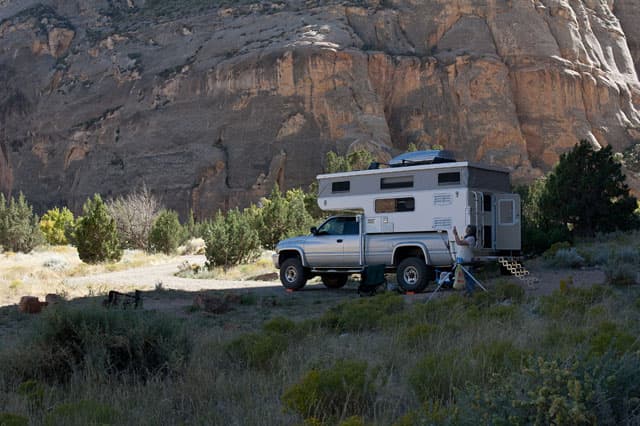
Above: Dinosaur National Monument, Echo Park campground, Utah
TCM: You have enjoyed a long history of camping and have owned many different RVs over the years. Tell us about your various camping experiences and how you wound up with a Hallmark.
Bob: I started camping as a teenager with my father. Every summer we would go to the Owens Valley in the Eastern Sierras. We would tent camp and river fish for trout. When I was around eighteen years old, I bought a VW Microbus. It was that wasn’t outfitted for camping, but I removed the seats, used a Coleman stove, and slept in sleeping bags.
A few years later, I bought a 1968 Westfalia VW camper. It had a water tank, sink with a hand pump, and a Coleman stove. After that, I was in the army for two years, got married in Panama to my lovely wife Diana, came back to the United States. The Volkswagon camper took us to Canada, Idaho, and other places within 1000 miles of our home in California. When I would get three days off in a row, we would load the camper and go.
In 1971, I got a Chevy half ton four-wheel drive pick up truck. We had been married a few years so we didn’t have the funds to get a truck camper. Instead we bought a camper shell and used that. With the truck, camper shell, and our boat, we would often drive two hundred miles to go bass fishing. About that time, my dad got a pickup camper. Dad would lend the camper to me and I’d load it on my truck. I borrowed dad’s camper now and then for a few years. Then dad sold his camper, and my wife and I went back to tent camping. After camping in the camper the tent camping wasn’t as comfortable anymore.
Soon after I bought a 1985 Fleetwood Southwind Class A motorhome. We had the motorhome for ten years and put over 100,000 miles on it. We went a lot of places with the Class A, but it was limiting because we were not towing a car. The motorhome was our sole means of camping for many years. At twenty-four feet in length, we really were limited to pavement with the motorhome.
Then we got a travel trailer and used it for a long time. The travel trailer worked fine for trips where we would stay somewhere for two weeks or a month. We would go to Yellowstone National Park in the spring and stay for a month.
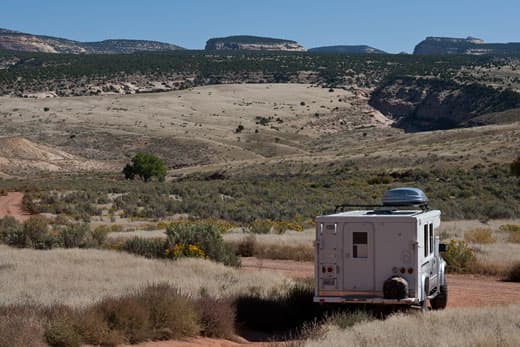
Above: Dinosaur National Monument road to Echo Park campground, Utah
TCM: And then you got a truck camper?
Bob: Yes. Three years ago, I started looking at pop-up truck campers. The big advantages to a pop-up truck camper are their low weight and low center of gravity. I sometimes need four-wheel drive low range to drive steep grades and switchbacks. When I went to Titus Canyon in Death Valley National Park, there were times that I needed to be in first gear low range going down hill. Having four wheel drive low range, I did not need to put my foot on the brake constantly.
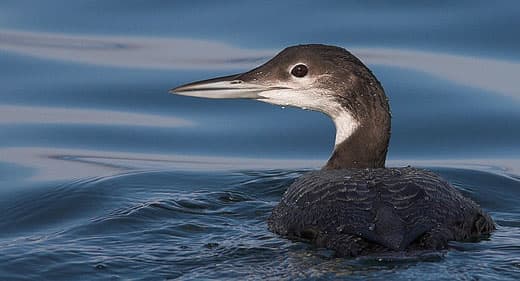
Above: Common Loon, Point Wilson, Port Townsend Washington
TCM: After using a motorhome and travel trailer, why did you need to go off road?
Bob: I’m into wildlife photography, primarily birds. With my photography, we will travel about 12,000 miles a year and spend three months in the camper. The truck camper allows me the ability to access remote areas in pursuit of wildlife and the ability to stay for up to a week without support.
In remote areas there’s a better chance of acquiring images with less people around. After about three months of research I came to the conclusion that a pop-up truck camper would be the best solution for my needs. So we went to Colorado around my birthday in October to pick up our Hallmark Cuchara.
 |
 |
 |
LEFT: Craters of the Moon National Monument, Idaho MIDDLE: Convict Lake, Mammoth, California RIGHT: Canyonlands National Monument, Utah
TCM: The Cuchara is a nice camper. We camped in a Cuchara in Rocky Mountain National Park back in October. Why that particular model?
Bob: It was the right size and had the features and storage we wanted. Through all of my research, I thought a Hallmark was the best I could buy for my needs.
I like that the roof on a Hallmark is one piece fiberglass. The sides are also molded fiberglass. I like that the roof lift is motor gear driven. The roof has a 400 pound capacity which is good because I have a canoe I travel with. I can get up and walk on the roof of our Hallmark without any difficulty. My weight isn’t going to damage the roof.
I like the bathroom in the Cuchara and that it’s a wet bath. For me, it’s great to be able to get up in the middle of the night and use a bathroom in our camper. I would not have a camper without the bathroom toilet.
I eliminated the oven when I ordered my Cuchara and just got the cooktop. Now, I have cabinetry space for pots, pans, cutting boards, and food. For me, that storage is much more valuable than an oven. I would never use it and it would be wasted space.
TCM: What modifications have you made to your Hallmark?
Bob: After some measurements, I bought a hall runner mat carpet with rubber backing. It’s also removable so I can take it out and hose it off now and then. I also put in another shelf in one lower cabinet for canned goods. That doubled the capacity of the cabinet just by installing a shelf.
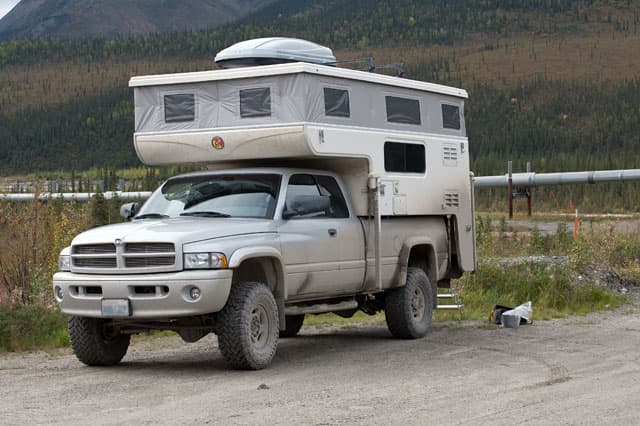
Above: Dalton Highway Alaska with the Trans Alaska pipeline in background
TCM: Any modifications to your truck to handle off-road conditions?
Bob: I have driven my truck camper to the two highest points in Alaska and Canada without going on the ice roads. I need my truck to be reliable so I haven’t risked altering it or anything that could compromise the reliability of the engine. I do keep our truck well maintained.
One thing I have done is use an extended oil filter. It’s steel and mounts under the frame. It filters the oil to a higher degree. Every 10,000 miles, I drain off a small vile and take it to a truck place. They analyze it and tell me the remaining life of the oil. I change the filter every 10,000 miles. This set-up means that on extended trips I don’t have to go for an oil change.
I have Toyo mud and snow tires. They weigh about seventy-six pounds a piece, which does lower my fuel economy a bit. The Toyos are also ten ply and can carry 65 psi. While traveling with my camper, I have my front tires between 58 and 60psi and my rear tires at 65. The tires have worn really well.
In Alaska, every time we would take a break I would walk around the truck, look at my tires and suspension, pop the hood, and check my turnbuckles. In Fairbanks I found a brass object in the lug of the tire. I got my tool kit and was going to pull it out. My wife said it may go flat, so I checked the air every three to four hours and there wasn’t a problem. It was a shell casing, it was the start of moose season and someone ejected a spent cartridge on the highway.
I use full synthetic fluids in the truck. I can not have equipment failures. I want to enjoy what I’m out there to do. I keep a log book and every time I do any maintenance to the truck, I record it with the date, time, and mileage.
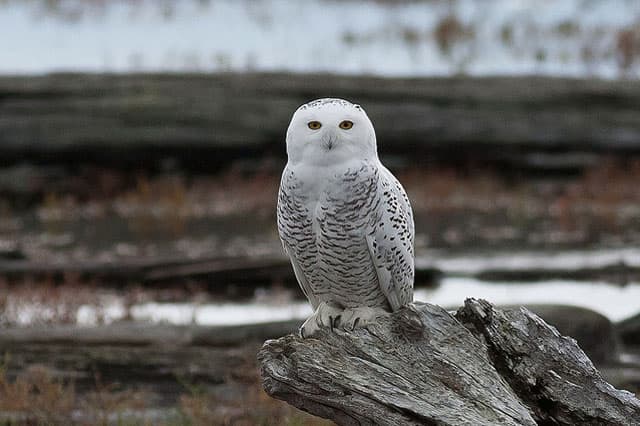
Above: Snowy Owl, Dungeness Spit, Sequim, Washington
TCM: We should all keep a log book for truck and camper maintenance. When did you get into nature and wildlife photography?
Bob: I initially started my photography in 1968 when we were in Panama. I always took pictures with a 35 millimeter film camera. When I retired in 2000, I was able to pursue my photography interest full time.
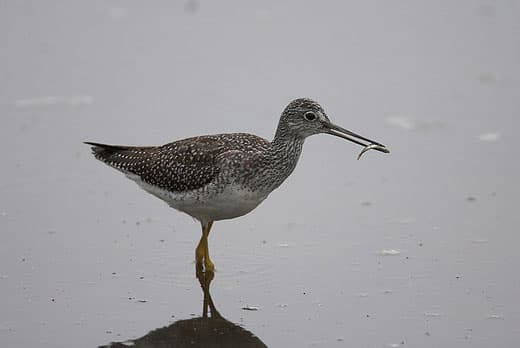
Above: Lesser Yellowlegs, Kahtai Lagoon, Port Townsend, Washington
All of my truck camper travels are photography oriented. We go to wildlife refugees and national parks.
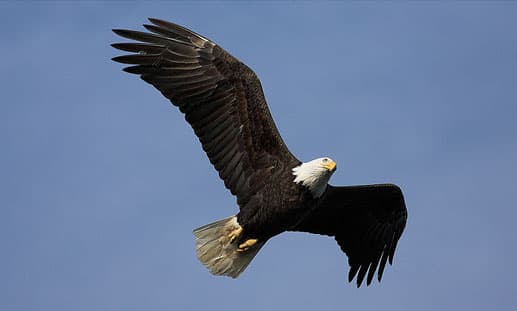
Above: Bald Eagle, Point Wilson, Port Townsend, Washington
With the camper, I am able to take all of my gear and stay out during the year doing photography. Our daily pursuit is to find a combination of suitable places for painting and photography.
 |
 |
 |
LEFT: Denali National Park, Alaska MIDDLE: Dalton Highway, Alaska RIGHT: Kootenai River north of Bonners Ferry, Washington
The camper makes my photography and my wife’s painting much better because we can reach remote areas, camp for extended periods, and we’re self-sufficient. We don’t have to look for campgrounds. Having that kind of flexibility to find bears feeding on salmon, or nesting birds has made a huge impact.
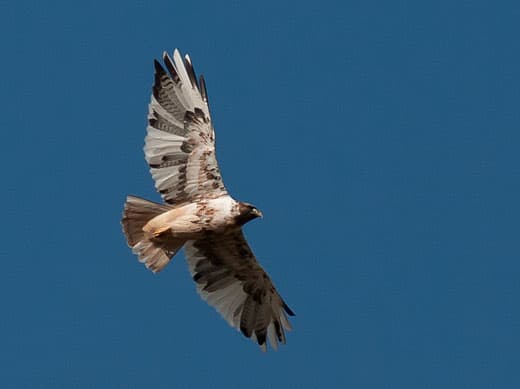
Above: Leucistic Red-tailed Hawk, Ferndale, Washington
TCM: What’s a typical day for you like when you’re out in your truck camper and taking photographs?
Bob: I’m an early riser. In the morning, I’ll pull the blinds up to look out and see what kind of day it is. I’ll eat, have my chai, prepare my equipment, check the batteries, get extra batteries, and go out walking for up to four hours. In the morning, I’ll take a smaller camera rig and no tripod. Sometimes I’ll take lunch. I always take a day pack with water and a few other essentials. My wife is a later riser. She gets up, has coffee, gets her easel out, and looks for a painting subject.
I usually get back around lunch time. I download or put images into files. If the computer is low on batteries, I have a quiet generator with a platform on the back. Hallmark put in extra 12v and 110 outlets for me. While the generator is running, I am downloading 300 to 400 images which takes twenty to thirty minutes with my sixteen megapixel camera. Then, I back up my files on the hard drive so I have two copies.
I’ll go out again in the afternoon. Usually I’ll switch to a 17-35 millimeter lens for scenic photography. Sometimes I’ll sit in my chair, have a cool beverage, and see what birds come around. In the evening I go out again, and look for scenery and wildlife.
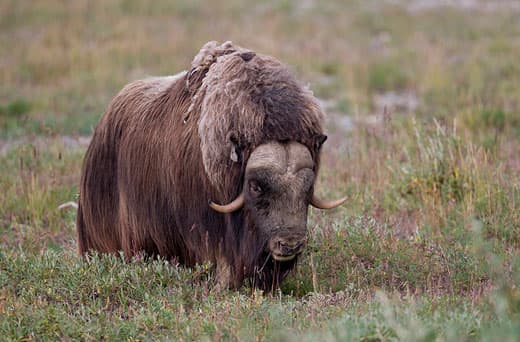
Above: Musk Ox, Dalton Highway, south of Deadhorse, Alaska
TCM: Sounds like fun. Have you had any close encounters with wildlife during your photography adventures?
Bob: We went to Alaska looking for musk ox. There was beautiful light in August in Alaska with the golden late evening light lasting for hours. It was gorgeous. When we found the musk ox, we parked off the road and took pictures. Later we fixed dinner and looked out window with musk ox about two hundred yards away. Where else can you take a camper out and see wild musk ox? That’s the advantage of truck campers.
In Hyder, Alaska I have seen grizzly and black bears fifty to one hundred feet away catching salmon. About twenty-five miles up the road was Salmon Glacier, which is the fifth largest glacier in North America.
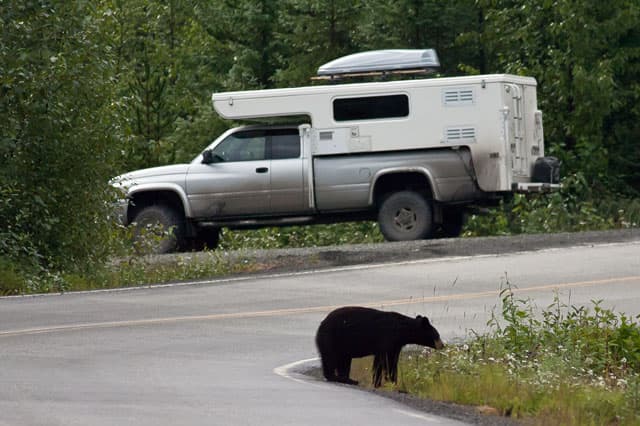
Above: British Columbia near Terrace, Canada
One time we parked the rig and discovered a black bear about sixty feet away.
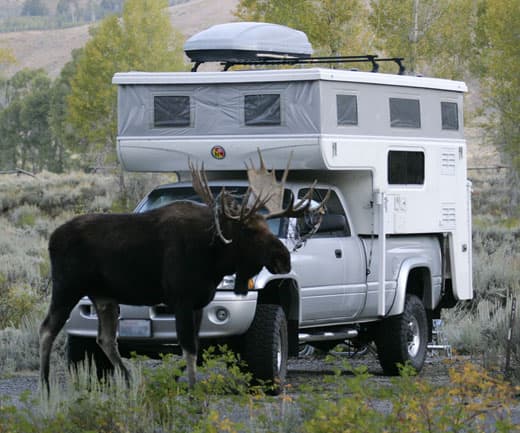
Above: Grand Teton National Park, Gros Ventre campground, near Jackson, Wyoming
When we were in the Tetons we had a moose walk in front of the camper.
TCM: That’s close. What’s next on your bucket list?
Bob: I will make another trip in August to British Columbia and spend a couple weeks up there looking for the Kermodei black bear. Next year we’re going on the lower road in Canyonlands National Park. We’ll take four days, in late September. I also want to ship the camper to Argentina and spend six months in South America.
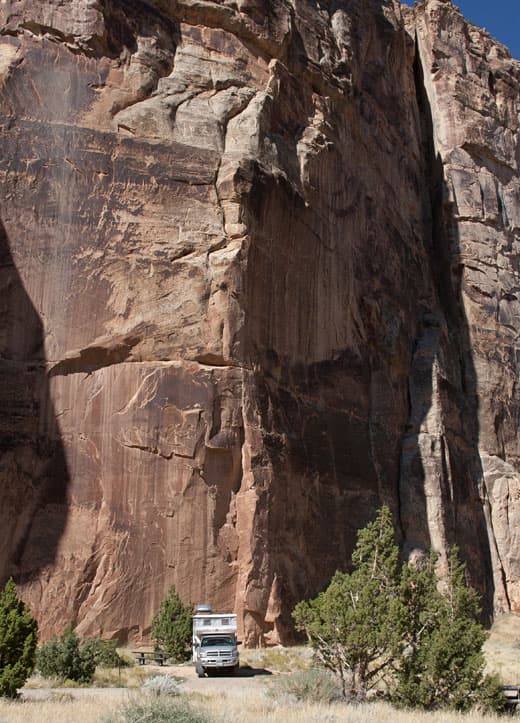
Above: Dinosaur National Monument, Echo Park campground, Utah
TCM: Now that’s a trip we want to cover here in Truck Camper Magazine. Is there anything that we didn’t talk about that you’d like to add to your interview?
Bob: Truck camping is more pleasurable and less stressful than towing a trailer. I just like driving a pickup truck. I can travel to places we couldn’t otherwise get to. We save on fuel costs compared to towing a trailer. It’s so relaxing. When we were pulling a trailer, I had anxiety. I don’t like anxiety.
Now when we go for six to eight weeks on the road, I don’t want to return home. I enjoy truck camping. It’s so relaxing. I’m no longer fearful about taking a road I don’t know because I may not be able to turn around with a trailer. With our truck camper, we can always turn around.
With our Hallmark, I have the freedom to go more places than I could go with a motorhome, travel trailer, or fifth wheel. I love it. Truck campers are the way to go for me!
| BOB AND DIANA WHITNEY’S TRUCK CAMPER RIG |
| Truck: 2002 Dodge Ram 2500, crew cab, single rear wheel, long bed, 4×4, diesel |
| Camper: 2010 Hallmark Cuchara |
| Tie-downs and Turnbuckles: Stainless steel and chain |
| Suspension Enhancements: Additional leaves to the spring pack, Air Bags |
| Gear: 35 inch Toyo M/T load range E tires with 4.11 gears, 60 gallon fuel tank from Aero Tanks from San Bernandino, California, took place of factory tank, out of aluminized steel, whole new fuel delivery system called Air Dog, supplies the engine with a constant fuel pressure of about 15 psi that remains constant under load, BD industries gauges for fuel pressure, turbo boost and exhaust. Yukon Spin Free kit with Warn hubs. Heavy duty two quart external oil filter. |
